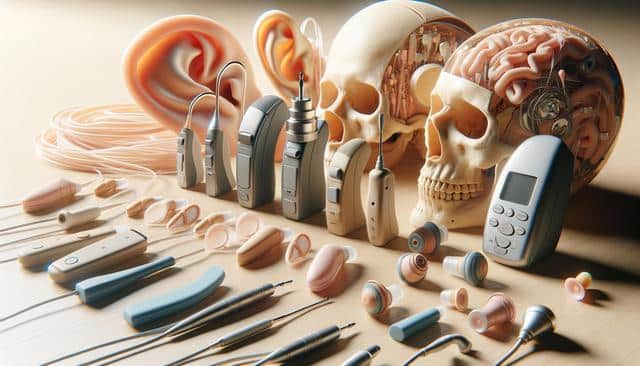
Hearing Aids & Assistive Devices:Explore How Advanced Hearing Technology Is Enhancing Sound Precision
The Progression of Hearing Aid Technology
Hearing aids have undergone a remarkable transformation over the past few decades. What was once bulky and limited in functionality has evolved into compact, discreet devices offering advanced sound processing and improved user comfort. Today’s hearing aids incorporate digital algorithms that adapt to various environments, allowing users to experience clear, balanced audio whether they are in a quiet room or a bustling public space. These technological advancements are not only enhancing sound precision but also contributing to a more natural listening experience.
Modern hearing aids now feature:
- Directional microphones that focus on speech and reduce background noise
- Wireless connectivity for seamless integration with smartphones and other devices
- Rechargeable batteries for convenience and sustainability
- Customizable settings tailored to individual hearing profiles
These innovations are the result of ongoing research that aims to bridge the gap between hearing loss and everyday communication. As hearing aid technology continues to advance, users can expect even greater improvements in sound fidelity and ease of use.
Assistive Listening Devices: Expanding the Possibilities
Beyond traditional hearing aids, a wide range of assistive listening devices (ALDs) are making it easier for individuals with hearing challenges to stay engaged in different environments. ALDs can be used in conjunction with hearing aids or independently, depending on the user’s needs. These devices are especially useful in settings where distance, background noise, or acoustics make hearing difficult.
Common types of ALDs include:
- FM systems that transmit sound directly from a microphone to the listener’s device
- Infrared systems for use in theaters and conference rooms
- Induction loop systems found in public venues like churches and auditoriums
- Personal amplifiers for one-on-one communication or television listening
Each of these tools plays a vital role in enhancing communication and accessibility, empowering users to participate fully in conversations, events, and daily activities without feeling isolated or overwhelmed by auditory limitations.
Design Meets Functionality in Modern Hearing Aids
As hearing aids become more advanced, their design has also evolved to meet the aesthetic and lifestyle needs of users. Gone are the days of conspicuous devices; today’s models are sleek, lightweight, and available in a variety of colors and styles. This shift in design philosophy has helped reduce the stigma once associated with wearing hearing aids, encouraging more individuals to seek help for hearing loss without hesitation.
Key design features include:
- Behind-the-ear and in-the-ear models that suit different preferences
- Minimalist profiles for discreet wear
- Durable materials that resist moisture and dust
- Touch controls and mobile app integration for ease of use
This blend of form and function reflects a broader trend in personal technology, where usability and appearance are equally important. The result is a new generation of hearing aids that users are proud to wear—choices that not only improve hearing but also complement their personal style.
Enhancing Mobility with Stylish Rollators
While hearing aids focus on improving auditory experiences, modern mobility aids like rollators are transforming physical independence. Rollators have become a popular choice for those needing support while walking, offering stability without compromising style. Today’s models are thoughtfully designed to suit various lifestyles, whether for indoor use, outdoor navigation, or travel.
Contemporary rollator features often include:
- Foldable frames for easy transport and storage
- Ergonomic handgrips and adjustable heights for comfort
- Built-in seats and storage bags for convenience
- Modern color options and materials for visual appeal
These enhancements not only improve mobility but also empower users to stay active and socially engaged. The emphasis on both function and design ensures that rollators are viewed as empowering tools rather than restrictive devices, enabling users to maintain their lifestyle with confidence and independence.
Integrated Solutions for Enhanced Daily Living
As technology continues to advance, the integration of hearing aids and mobility aids into daily life becomes increasingly seamless. These devices are not standalone tools but part of a broader ecosystem of support designed to enhance quality of life. From synchronized devices that work together to smart features controlled via mobile apps, the focus is on creating a user-friendly experience that adapts to individual needs.
For instance, some newer hearing aids can automatically adjust settings based on geolocation data, learning from the user’s habits and preferences. Similarly, rollators now feature smart braking systems and enhanced maneuverability, making them safer and more intuitive to use. The future may see even greater connectivity between devices, offering a unified approach to managing both hearing and mobility challenges.
By embracing these innovations, users are not just addressing physical limitations—they are actively reclaiming their independence and enriching their everyday lives. With continued development and user-focused design, assistive technologies are opening up new possibilities and redefining what it means to live well with hearing or mobility needs.
Conclusion: Embracing a New Era of Assistive Technology
For individuals seeking to improve their auditory or physical mobility, the current landscape of assistive devices offers a wealth of effective and thoughtfully designed options. Hearing aids and assistive listening devices now deliver enhanced sound clarity tailored to unique hearing profiles, while modern rollators combine practical functionality with elegant design to support an active, independent lifestyle. As these technologies continue to evolve, users can look forward to even more refined experiences that align with their needs and preferences. Embracing these tools not only enhances daily living but also fosters greater confidence and connection in every aspect of life.